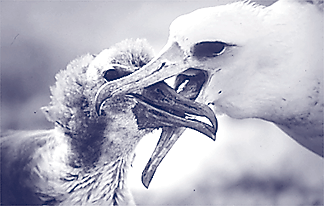Published in the Ocean Watch column, Honolulu Star-Advertiser © Susan Scott
June 22, 1998
ONE July, years ago, I stood on the beach at Tern Island in Hawaii’s northwest chain, and watched a Laysan albatross feed its chick. I’ll always remember it.
It was late in the breeding season and this was one of the few albatrosses still feeding. The goose-sized parent landed clumsily near its enormous chick, then began some rather ungraceful heaving and shuddering to bring up its food.
The chick, so fat it looked like a beanbag with legs, waddled to the newly arrived parent and began begging. The parent, however, would not be rushed. It turned its back and continued regurgitating.
 A mother albatross grasps her chick’s beak to feed it richfish oil.
A mother albatross grasps her chick’s beak to feed it richfish oil.
Some albatross fly as far as California in search of food for their babies.
©1998 Susan Scott
When dinner was finally served, I was surprised: The chick didn’t put its beak down the parent’s throat, as I expected, but rather, the parent grasped the chick’s beak sideways.
To picture this, think of a pair of scissors trying to cut across the blades of a second pair of scissors.
How can this work? I wondered. It looked impossible for the parent to actually get any food inside that baby’s beak.
It worked just fine, of course, because it wasn’t solid fish the parent was delivering, but fish oil, a vile-smelling brown liquid that dripped from the parent’s beak into the chick’s. A bit spilled onto their snow-white chest feathers.
When the feeding was over, the satisfied chick settled down for a snooze and the parent took off once again to the wild blue yonder.
I watched the big bird head out to sea. Where is it going? I wondered, as it disappeared into the horizon. And how will it ever get back?
Albatross researchers still don’t know how these seabirds find their way back to Tern Island, but they recently learned where some of them go for food to feed their chicks — all the way to San Francisco and Alaska.
Such great distances seem improbable, but by attaching radio tags to 26 of Tern Island’s albatrosses, researchers from Wake University in North Carolina can now track the birds’ exact paths.
Three black-footed albatrosses (close cousins of Laysans) flew over 2,600 miles from Tern Island to the California coast and back. One Laysan went to the Aleutian Islands in Alaska, over 2,000 miles away, came back to Tern, stayed one day, then went back to the Aleutians.
Albatrosses can cover these astounding distances because they are masters of flight, soaring on the winds with such efficiency that they exert little energy of their own.
They also store food in the form of fish oil, using the nonfat parts for their own survival, then bringing the calorie-rich liquid home to their chicks. Because of this, albatross chicks grow fat, thus surviving for weeks between feedings.
You can follow this ongoing albatross tracking on the Internet at http://www.wfu.edu/albatross. The study is sponsored by Wake University and the National Science Foundation.